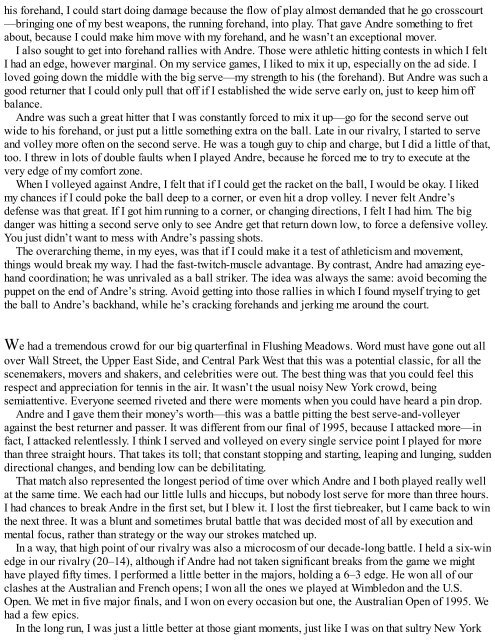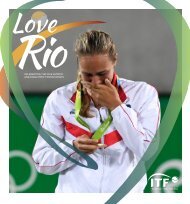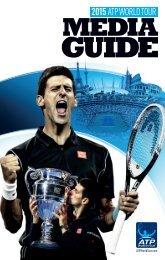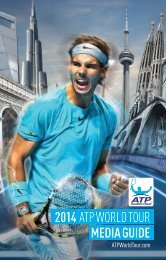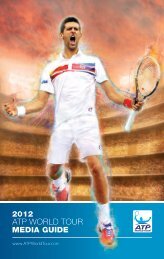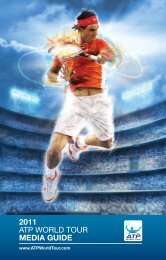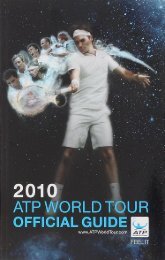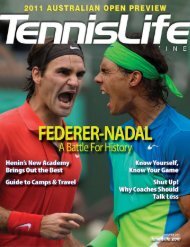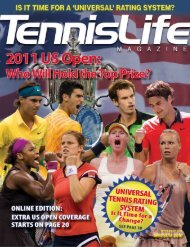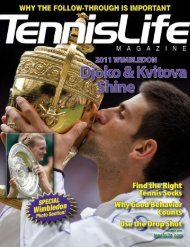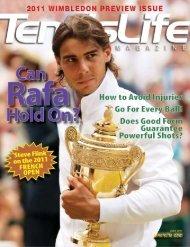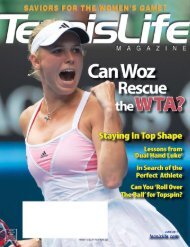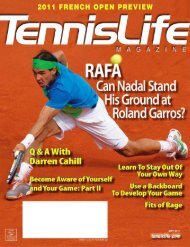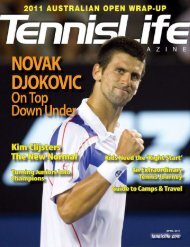A Champion's Mind - Pete Sampras
www.tennismoscow.me Insta:TENNISMOSCOW
www.tennismoscow.me Insta:TENNISMOSCOW
You also want an ePaper? Increase the reach of your titles
YUMPU automatically turns print PDFs into web optimized ePapers that Google loves.
his forehand, I could start doing damage because the flow of play almost demanded that he go crosscourt<br />
—bringing one of my best weapons, the running forehand, into play. That gave Andre something to fret<br />
about, because I could make him move with my forehand, and he wasn’t an exceptional mover.<br />
I also sought to get into forehand rallies with Andre. Those were athletic hitting contests in which I felt<br />
I had an edge, however marginal. On my service games, I liked to mix it up, especially on the ad side. I<br />
loved going down the middle with the big serve—my strength to his (the forehand). But Andre was such a<br />
good returner that I could only pull that off if I established the wide serve early on, just to keep him off<br />
balance.<br />
Andre was such a great hitter that I was constantly forced to mix it up—go for the second serve out<br />
wide to his forehand, or just put a little something extra on the ball. Late in our rivalry, I started to serve<br />
and volley more often on the second serve. He was a tough guy to chip and charge, but I did a little of that,<br />
too. I threw in lots of double faults when I played Andre, because he forced me to try to execute at the<br />
very edge of my comfort zone.<br />
When I volleyed against Andre, I felt that if I could get the racket on the ball, I would be okay. I liked<br />
my chances if I could poke the ball deep to a corner, or even hit a drop volley. I never felt Andre’s<br />
defense was that great. If I got him running to a corner, or changing directions, I felt I had him. The big<br />
danger was hitting a second serve only to see Andre get that return down low, to force a defensive volley.<br />
You just didn’t want to mess with Andre’s passing shots.<br />
The overarching theme, in my eyes, was that if I could make it a test of athleticism and movement,<br />
things would break my way. I had the fast-twitch-muscle advantage. By contrast, Andre had amazing eyehand<br />
coordination; he was unrivaled as a ball striker. The idea was always the same: avoid becoming the<br />
puppet on the end of Andre’s string. Avoid getting into those rallies in which I found myself trying to get<br />
the ball to Andre’s backhand, while he’s cracking forehands and jerking me around the court.<br />
We had a tremendous crowd for our big quarterfinal in Flushing Meadows. Word must have gone out all<br />
over Wall Street, the Upper East Side, and Central Park West that this was a potential classic, for all the<br />
scenemakers, movers and shakers, and celebrities were out. The best thing was that you could feel this<br />
respect and appreciation for tennis in the air. It wasn’t the usual noisy New York crowd, being<br />
semiattentive. Everyone seemed riveted and there were moments when you could have heard a pin drop.<br />
Andre and I gave them their money’s worth—this was a battle pitting the best serve-and-volleyer<br />
against the best returner and passer. It was different from our final of 1995, because I attacked more—in<br />
fact, I attacked relentlessly. I think I served and volleyed on every single service point I played for more<br />
than three straight hours. That takes its toll; that constant stopping and starting, leaping and lunging, sudden<br />
directional changes, and bending low can be debilitating.<br />
That match also represented the longest period of time over which Andre and I both played really well<br />
at the same time. We each had our little lulls and hiccups, but nobody lost serve for more than three hours.<br />
I had chances to break Andre in the first set, but I blew it. I lost the first tiebreaker, but I came back to win<br />
the next three. It was a blunt and sometimes brutal battle that was decided most of all by execution and<br />
mental focus, rather than strategy or the way our strokes matched up.<br />
In a way, that high point of our rivalry was also a microcosm of our decade-long battle. I held a six-win<br />
edge in our rivalry (20–14), although if Andre had not taken significant breaks from the game we might<br />
have played fifty times. I performed a little better in the majors, holding a 6–3 edge. He won all of our<br />
clashes at the Australian and French opens; I won all the ones we played at Wimbledon and the U.S.<br />
Open. We met in five major finals, and I won on every occasion but one, the Australian Open of 1995. We<br />
had a few epics.<br />
In the long run, I was just a little better at those giant moments, just like I was on that sultry New York


